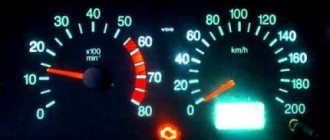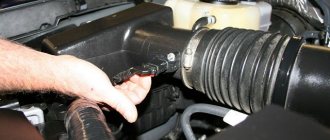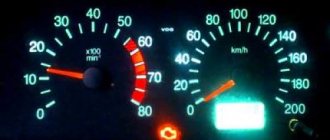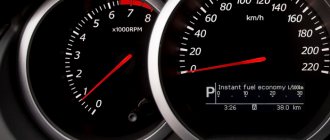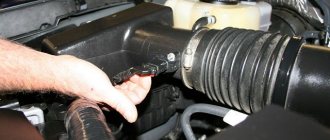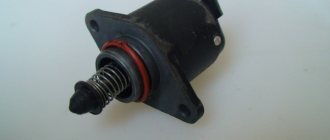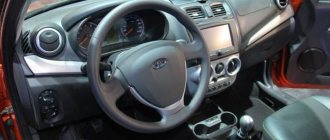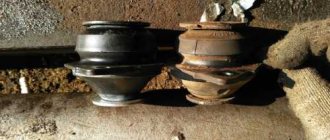Idle mode means that the engine is running in neutral. In this state, the torque from the engine is not transmitted through the gearbox to the drive wheels. At the same time, quite often drivers notice how engine vibrations noticeably increase at idle and are transmitted to the body. In its normal state, the engine practically does not vibrate, although minimal vibrations are allowed here, and they can be considered normal for a car. We must not forget that during the cold season, vibrations increase compared to engine operation in warm weather. When the engine warms up, the vibrations return to normal after a few minutes. If additional jerks, dips and omissions are not detected, everything is fine with the motor. The absence of extraneous noises and sounds is a pleasant signal for the motorist.
How to eliminate engine vibration at idle.
At idle
Frequent causes of engine vibration at idle speed are associated with improper operation of power unit components, and less commonly, with breakdowns of transmission parts. Shaking at idle is felt immediately after starting the car and when stopping. The causes of body shake can be:
- failure of the engine mount (support);
- clogged fuel pump, worn filter;
- spark plug fault;
- wear of the CPG (parts of the cylinder-piston group of the internal combustion engine).
An engine mount is a rubber-metal or hydraulic gasket between the engine and the body parts of the car. The main purpose of the pillow is to soften vibrations and detonation from a running engine, which transmits vibration to the body.
Most often, the engine is mounted on four or five supports; the breakdown of one of them causes the body to vibrate abnormally.
In 90% of cases, support failure occurs due to a break in the rubber part of the metal support. The average service life of an engine mount is 100,000 km.
If your car's fuel system is faulty, shaking may become noticeable when the engine is idling, at high speed, or accelerating. There are interruptions in the fuel supply, which is manifested by a sharp decrease in speed or a sharp increase.
Balancing the cylinder-piston group and crankshaft
Often, during repair work on a power unit, it is necessary to grind the crankshaft or replace it. This leads to weight changes. It usually becomes higher than with the old part. So that after this the engine does not tremble at idle, balancing is performed - to balance the balance of the crankshaft with the clutch mechanism and the flywheel. This is done by drilling out parts of the part to reduce weight.
Vibration may be a consequence of installing new elements of the cylinder-piston assembly. Especially if they have a different weight compared to old components. To prevent weight changes from leading to increased shaking of the running engine, it is necessary to weigh the parts of the cylinder-piston system before assembling the power unit.
Engine mounting
Strong vibration of the engine at idle speed can be caused by poor fastening of the power plant to the body. In some cases, it is possible to identify breakdowns of the protective cushion through which the motor is attached. It is advisable to carry out diagnostics together with an assistant, who will sequentially switch gears in the gearbox. An observer looking under the hood will identify which gears are causing problems.
Even after replacing the airbags, the shaking does not always leave the car. This is due to the need to properly configure and adjust the fasteners.
Failure can occur for any of the four supports (rear, front, bottom or top). However, practice shows that the most vulnerable is the front support. It is subject to increased static and dynamic load. As soon as one of the pillows breaks, then if no measures are taken, the rest will quickly break .
For novice drivers, vibration in the steering wheel at idle is not always obvious, so we recommend periodically undergoing diagnostics in specialized workshops or from experienced technicians. Otherwise, trouble cannot be avoided. If you decide to look for the cause yourself, then you need to use the method of exceptions, moving from simple to complex causes.
We recommend: How to determine that a valve in a car engine has burned out: signs and symptoms
Disorders in the nutrition system
Ultimately, they come down to improper formation of the composition of the combustible mixture. Typically, vibration at idle is a consequence of its depletion. It is possible to understand exactly which node or element is the source of the problem only with the help of special equipment. There are many reasons, below are just a few of them:
- fuel pump failure;
- contamination of the filter and (or) fuel line;
- clogged jets in the carburetor or nozzles in the ramp;
- incorrect carburetor settings, faulty sensors in the injection engine, etc.
Is the engine to blame - primary diagnosis
Idling is the operation of the engine in neutral gear mode or with the clutch disengaged. Therefore, if you notice that engine vibration appears at idle, and at the same time it is transmitted to the body, make sure that the reason lies in the engine itself. To do this, simply press the clutch pedal. If the situation has not changed, it means that the engine is indeed vibrating. If the vibrations stop, problems should be looked for in the gearbox (no matter whether it is automatic or mechanical) or in the clutch itself.
In this case, it is better to show the car to specialists, since the transmission is a very complex system that must be serviced by professionals. To check the condition of the box yourself, you can drain a small amount of oil and examine it. If there are metal shavings in the oil, and the lubricant itself is cloudy and has a burning smell, there can be no doubt that the gearbox requires serious repairs. If nothing like this is found in the oil, suspicion falls on the clutch.
Are all additives useful?
Not all fuel additives are useful and have a beneficial effect on the engine. Some not entirely honest manufacturers, even world-famous ones, follow the path of a little deception when, with the help of an additive, motor oil does not improve its physical and chemical properties, but only thickens. This is done to prevent oil from penetrating into the combustion chamber through chips and scratches, as well as to improve the distribution of lubricant over parts and stabilize the oil film, which, due to the reduced fluidity of the oil, remains on the rubbing surfaces longer.
Not a single professional service station technician will advise you on a thickening additive for motor oil. This is a temporary solution to the problem and, rather, even disguises it. Overly thick lubricant will even harm the engine in the long run. Each automaker recommends motor oil with certain mechanical and physico-chemical properties, since the operation of the engine of each specific brand is designed for certain conditions of lubrication, washing and cooling of its cylinder-piston group.
Changing such conditions will lead to overload and overheating of the engine, poor lubrication of the elements of its CPG and the washing off of carbon deposits from them. All this will certainly lead to serious damage and expensive repairs, although at first car owners notice positive changes.
Vibration at idle
Vibrations are the rattling sounds produced by the engine and felt by the driver when he holds the steering wheel.
If there are problems with the engine, the rattling from barely perceptible becomes very strong and unpleasant.
Signs
The main symptoms of this problem include:
- increased vibration of the steering wheel, which can be transmitted to the engine body;
- engine popping;
- engine jerks and failures;
- The tachometer readings exceed the permissible values for the car.
It will also be useful for you to know why the car shakes during acceleration and at high speed.
Causes
The main causes of engine vibrations include:
- engine tripping (uneven operation of the pistons or failure of one of them);
- incorrect motor mounting;
- faulty engine mounts;
- the crankshaft is unbalanced;
- the fuel system is dirty;
- improper fastening of other units;
- ignition system malfunction.
- One of the common mistakes associated with engine mounts is installing mounts from different materials.
The above reasons are valid for gasoline cars.
The reasons why the vibrations of a diesel engine have increased, due to the difference in design and operation from a gasoline engine, are slightly different:
- malfunction of the cylinder-piston group or gas distribution mechanism as a whole or in a separate cylinder;
- compression variation in cylinders;
- malfunction of the high pressure fuel pump, diesel injectors or timing belt teeth;
- incorrect injection advance angle.
Why is low engine idle dangerous?
No less a problem is reducing idle speed.
Low speeds can lead to the following consequences:
- fuel detonation in the cylinders does not occur completely;
- oil dilution;
- washing off the lubricant;
- coking of the motor.
It is also worth noting that at low idle speeds the car will stall, as it will not have enough revolutions to maintain operation. This, in turn, will increase the load on the ignition system, increasing wear on the car and reducing its service life.
Diagnostics
To carry out diagnostics, you should pay attention to the following points:
- check the injector/carburetor;
- take readings from the tachometer and pressure sensor and compare them with normal values;
- check the fastening of the motor and other components;
- run computer diagnostics of the car (if there are appropriate electronics on board).
Separately, it is worth mentioning the process of checking engine mounts, since their incorrect installation quite often causes problems, although they are easily diagnosed and corrected.
We recommend: How to insulate a car engine for the winter
Important! Since visible problems may hide other, more serious ones, if any problems occur, you should contact a car service center.
Checking the airbags is carried out as follows: one person sits behind the wheel, opens the hood and drives back and forth in place, the second person watches the engine at this moment - it should tilt evenly in all directions. If the engine rolls a little more in one direction, then the cushion on that side should be replaced.
What measures to take in case of strong vibration
When faced with strong vibrations, you can begin to combat the problem.
Engine adjustment
Adjusting the motor, first of all, includes checking the fastenings of the parts, as well as their condition. Having ensured that they are in good working order and correctly secured, it is necessary to calibrate their joint work.
The best way to do this is to check the factory settings in the instructions and reset all settings to them. Tuning includes not only tuning the operation of the engine itself, but also related systems - fuel supply, ignition, and so on.
If parts have been replaced, it is necessary to ensure that the parts in weight and material match those that were replaced - otherwise imbalance will occur.
Did you know? If the crankshaft is too heavy, it is lightened by cutting out holes, thereby knocking off the extra grams.
Correct installation of the timing belt
Another important element in solving the problem is installing the timing belt. The belt is responsible for the connection between the crankshaft and the camshaft, and its incorrect installation will inevitably lead to disruption of the gas distribution system.
The belt is replaced as follows:
- the protective belt cover is unscrewed;
- disconnects from the sensor;
- checking the coincidence of the marks on the camshaft gear (or shafts, if there are several of them), the gas distribution mechanism drive, the flywheel, the crankshaft - this will ensure the correct valve timing;
- the old belt is removed;
- a new belt is put on: first on the crankshaft pulley, then on the camshaft gear and pump;
- two revolutions of the crankshaft are carried out, after which the marks are checked - if the belt is installed correctly, they will coincide.
Wheels are out of balance
Vibrations caused by the wheels are usually felt through the steering wheel. One possible culprit for this could be a worn or damaged wheel bearing. Although they should last quite a long time, as with any other mechanical part of the car, they can fail at any time.
Another thing to look for is rod ends or ball joints. If the steering wheel feels normal while you're driving straight, but starts to shake when turning, this could indicate worn rod ends. However, if the steering wheel shakes in a straight line but stops when you turn, this may be a sign that the ball joint is faulty and should be replaced.
Vibration can be another cause of vibration and shaking in your vehicle. The term refers to any deviation from a truly circular rotation and is measured by a special indicator.
When driving
If your vehicle experiences vibration at speed that increases as it accelerates and does not stop while driving, the problem may be wheel imbalance. In addition, shaking when driving is associated with a malfunction of suspension and electrical parts:
- shock absorbers, struts;
- support bearing;
- tie rod end;
- hinges;
- high-voltage wire break.
When a high-voltage wire breaks, the car begins to vibrate when driving and a characteristic crackling sound is heard. Finding the location of the breakdown is quite simple; a spark is noticeable when the engine is running and idling. But if the electrical wiring is in order, but the appearance of extraneous sounds under the hood is noticeable, you should check the electronic sensors.
Best driving instructors:
Automotive instructor Svetlana Automatic transmission: Hyundai Accent Trains in Northern Administrative Okrug, North-Western Administrative Okrug, Khimki REVIEWS
Driving instructor Elena Automatic transmission: Chevrolet Lacetti Teaches in the Southern Administrative District, South-Eastern Administrative District, Vidnoye, Domodedovo REVIEWS
Driving instructor Marina Automatic transmission: Kia Cerato Manual transmission: Chevrolet Lanos Trains in Northern Administrative Okrug, Dolgoprudny REVIEWS
Automotive instructor Irina Automatic transmission: Kia Cerato Trains in SZAO, JSC REVIEWS
Driving instructor Natalya Automatic transmission: Kia Spectra Teaches in the Eastern Administrative District, Balashikha, Reutov REVIEWS
Driving instructor Oleg Automatic transmission: Chevrolet Lacetti Manual transmission: Chevrolet Lanos Trains in Northern Administrative Okrug, Dolgoprudny REVIEWS
Driving instructor Yana Automatic transmission: Kia Spectra Teaches in the Northern Administrative Okrug, Dolgoprudny REVIEWS
Driving instructor Yulia Automatic transmission: Chevrolet Lacetti Manual transmission: Chevrolet Lanos Trains in the Eastern Administrative District, South-East Administrative District, Lyubertsy, Reutov, Zheleznodorozhny REVIEWS
Automotive instructor Svetlana Automatic transmission: Chevrolet Lacetti Trains at Northwestern Administrative Okrug REVIEWS
Driving instructor Tatyana Manual transmission: Chevrolet Lanos Automatic transmission: Kia Spectr Teaches in Krasnogorsk REVIEWS
Driving instructor Peter Manual: Daewoo Nexia Trains at Northwestern Administrative Okrug REVIEWS
Automotive instructor Oksana Automatic transmission: Hyundai Accent Teaches in North-Eastern Administrative District, Mytishchi, Korolev, Pushkin REVIEWS
Driving instructor Dmitry Automatic transmission: Volkswagen Golf Manual transmission: Chevrolet Lanos Trains in North-East Administrative District, Northern Administrative District, North-Western Administrative District, Dolgoprudny REVIEWS
Driving instructor Oksana Automatic transmission: Kia Spectra Manual transmission: Chevrolet Lanos Trains in the Southern Administrative District, South-Western Administrative District, Vidnoye, Podolsk REVIEWS
Automotive instructor Dmitry Manual transmission: Lada Granta Teaches in the South-East Administrative District, Lyubertsy REVIEWS
How to preserve the life of engine parts in different operating modes?
In order to extend the life of the engine, you need not only to monitor the normal number of rotations of the crankshaft. It will also be necessary to be able to operate the vehicle correctly, choosing the optimal range of work. Experts recommend upshifting in the rpm range between peak torque and maximum power. At the same time, when driving under high load (for example, when driving uphill), there is no need to allow the shaft rotation torque to drop to values close to idle speed.
Why is it important to install the timing belt correctly?
If vibrations occur after replacing the timing belt, it is quite possible that it was installed incorrectly. Let us remember that this is a drive belt that transmits rotation from the crankshaft to the camshaft. Thanks to him, the gas distribution system, i.e. valve, works synchronously with the strokes of the piston system. If the belt is installed incorrectly, for example, there is a shift of at least one tooth, the valves begin to open and close at the wrong time.
This leads to dips in engine operation and tripping. Accordingly, at idle, as in the case of a faulty ignition, there is a strong vibration, which is clearly felt on the steering wheel and the entire body. The problem can be solved by correctly installing the belt. Therefore, it is advisable to replace it only in service centers.


